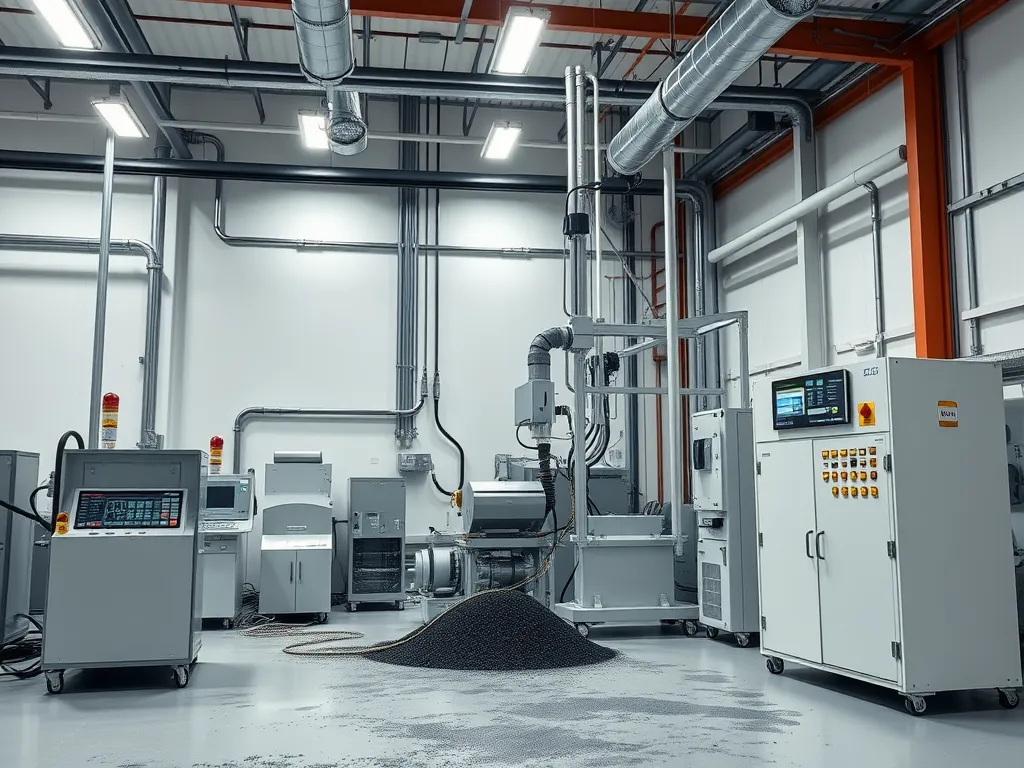Cold Mix Asphalt Testing Methods: Key Protocols for Durable Roads
Published on: October 17, 2025 | Last Updated: April 14, 2025
Written By: George Voss
Cold mix asphalt testing methods measure strength, density, and moisture resistance in pavements that harden at normal temperatures. Unlike hot-mix asphalt requiring 300°F heating, cold mix uses emulsified asphalt binders and cures without heat. Standardized tests like Marshall stability (ASTM D1559), bulk density (ASTM D2726), and water absorption (ASTM D5821) check load capacity, material consistency, and weather durability. These methods help engineers compare mix designs, validate specs, and predict how pavements handle traffic or freeze-thaw cycles.
This guide explains how to test cold mix asphalt from lab to jobsite. Get step-by-step breakdowns of Marshall stability procedures, voids calculations, and moisture resistance checks. Compare Superpave gyratory compaction with Marshall hammer methods. Learn field validation techniques like core sampling and skid resistance measurements. We’ll cover ASTM/AASHTO standards, binder viscosity tests, and cost-saving quality control tips.
Contents
What is Cold Mix Asphalt?
Cold mix asphalt is a road repair blend used without heat. It stays workable in bags for months. Builders use it to fix potholes, patch roads, or pave low-traffic lanes where hot mix plants can’t reach.
Composition and Application
Stone, sand, and a cold binder (asphalt mixed with water) form its base. Additives like lime or polymers boost stick and strength. This mix is poured cold, set by traffic load and air dry. Common uses:
- Quick pothole fills in rain or cold
- Driveway patches
- Rural roads with light cars
Advantages Over Hot-mix Asphalt
No heat cuts fuel use by 50% vs hot mix. It bonds in wet weather and stays soft until packed. Tests focus on how it holds shape without heat, fights water harm, and stays dense over time. Key test perks:
- No heat labs: Tests run at 40-70°F
- Wet-set checks: How water changes strength
- Long-term track: Slow cure vs fast fix
These traits shape the tests used to check its grit and grip. Next, we break down the core steps to test cold mix asphalt.
Core Testing Procedures for Cold Mix Asphalt
Cold mix asphalt testing methods verify performance under real-world conditions. These procedures focus on strength, density, moisture resistance, ensuring the material meets industry standards like ASTM or AASHTO.
Marshall Stability and Flow Test (ASTM D1559)
The Marshall test evaluates load-bearing capacity under traffic stresses. It applies to cold mix asphalt testing for temporary repairs or low-volume roads.
Purpose of the Marshall Test
This method compacts samples into cylindrical molds using 75 blows per side. Engineers measure maximum load (stability) in pounds-force before failure. Flow, recorded in 0.01-inch units, tracks deformation during loading. Ideal results balance stability above 1,500 lbf with flow between 8-18 units.
Interpreting Stability and Flow Values
High stability with low flow indicates brittle mixes prone to cracking. Low stability with high flow suggests weak pavements. Cold mix asphalt testing specifications often require adjustments in bitumen content or aggregate gradation if values fall outside target ranges.
Density and Specific Gravity Tests
Density impacts durability. Loose mixtures lead to premature rutting; over-compacted ones crack under thermal shifts.
Bulk Density Analysis (ASTM D2726)
This lab test for cold mix asphalt uses a parafilm-coated sample submerged in water. Bulk density (lbs/ft³) determines compaction efficiency. Field cores must achieve 93-97% of lab density to pass quality checks.
Voids in Mineral Aggregate (VMA) Calculations
VMA measures air voids between coated aggregates. Cold mix asphalt testing methods target 14-18% VMA. Values below 14% risk binder drainage; above 18% weaken structural integrity.
Moisture Susceptibility Evaluation
Water damage causes 70% of cold mix failures. Testing identifies mixes prone to stripping or disintegration.
Water Absorption Testing (ASTM D5821)
Samples soak in water for 24 hours. Weight gain over 2% signals excessive void spaces. High absorption rates require adding anti-stripping agents like hydrated lime.
Indirect Tensile Strength for Moisture Resistance
This cold mix asphalt quality test compares dry vs. wet sample strength. Tensile strength ratios below 80% fail specifications. Results guide binder modifications or compaction protocol changes.
With core performance metrics validated, the next phase focuses on optimizing binder behavior during installation.
Cold Mix Asphalt Binder and Mixture Tests
Binder properties dictate cold mix performance under traffic loads. Two critical evaluations ensure mixtures meet specifications: viscosity checks on binders plus compaction trials replicating field conditions.
Viscosity Analysis
Bitumen viscosity determines workability during placement plus long-term deformation resistance. Testing occurs at temperatures below 40°C for cold mixes, unlike hot-mix methods requiring 135-165°C.
Rotational Viscometer (ASTM D2171)
The Brookfield rotational viscometer spins a spindle submerged in emulsified binder at 60 RPM. Measured torque converts to viscosity in centipoise (cP). Cold mix binders typically range between 2,000-5,000 cP for proper aggregate coating without segregation.
Role of Binder Viscosity in Performance
High viscosity causes poor workability, leaving voids exceeding 8%. Low viscosity leads to rutting under loads over 3 kN. Optimal values balance density targets (96-98% Gmm) with stability above 4,500 N in Marshall tests.
Compaction Methods
Lab compaction simulates roller passes to predict field density. Cold mixes require modified techniques due to lower heat levels compared to hot mixes.
Superpave Gyratory Compaction (SGC)
SGC applies 600 kPa pressure at 1.25° tilt, rotating specimens 30-100 times. This mimics slow-moving rollers, creating specimens for evaluating density gradients. Cold mixes compacted via SGC show 2-3% higher voids versus Marshall methods.
Marshall Compaction (MC)
MC uses 4.5 kg hammers dropping 75 times per side. Though developed for hot mixes, modified MC with 50 blows suits cold mixes. Results correlate with field cores when testing 6-inch diameter samples cured 72 hours.
Validating lab results requires comparing compacted specimens against in-situ cores. Next, we explore how quality protocols bridge lab data to real-world pavement behavior.
Also See: Bitumen in Asphalt Pavement Design: Key to Durability
Quality Control and Validation
Verifying cold mix asphalt performance requires rigorous checks during production. These steps confirm the material meets design specs before deployment.
Laboratory Vs. Field Performance Testing
Lab tests simulate long-term conditions using controlled settings. Marshall Stability checks load-bearing capacity under fixed temps. Field tests track real-world behavior, like settling under traffic loads. Both methods complement each other to spot weaknesses early.
Layer Thickness Measurement
Nuclear density gauges or core samples verify installed thickness. Cold mix layers must stay within ±0.25 inches of targets to prevent premature rutting. Thinner sections risk cracking; thicker ones waste resources.
Traction and Skid Resistance Tests
The British Pendulum Test (BPT) or ASTM E274 skid trailer measure surface friction. Cold mix needs skid numbers above 35 for safe driving in wet conditions. Low values trigger texturing fixes like chip seals.
Quality Assurance Processes
Third-party inspectors cross-verify results using standardized protocols. Batch samples get tested every 500 tons to maintain uniformity. Non-compliant lots get rejected or reprocessed.
Back-Calculating Design Recipes
Engineers adjust binder percentages based on ITS (Indirect Tensile Strength) outcomes. If moisture resistance drops 15% below targets, emulsified asphalt content rises by 0.5-1%. This fine-tuning optimizes durability.
Repeating Tests for Consistency
Running three Marshall Stability tests per batch catches mix variations. Results with over 10% deviation trigger equipment recalibration. Consistent flow values between 8-14 units indicate proper workability.
With quality benchmarks confirmed, the next phase focuses on monitoring installed pavement under live conditions.

Field Inspection and Performance Evaluation
Field inspections verify how cold mix asphalt performs under real-world conditions. These evaluations complement lab tests by measuring structural integrity, surface quality, and long-term resilience. Three key methods dominate this phase.
Pavement Core Sampling
Core sampling extracts cylindrical sections of cold mix asphalt pavement using diamond-tipped drills (typically 4” diameter). ASTM D5361 specifies methods for measuring in-place density and layer thickness. Engineers compare core densities to lab-compacted samples – deviations exceeding 5% signal compaction issues. This cold mix asphalt quality test identifies weak spots needing repair.
Surface Texture and Thickness Assessment
Laser profilers measure surface texture depth (MTD) to ensure skid resistance meets ASTM E965 standards. Thickness checks use ground-penetrating radar or manual calipers per ASTM D3549. Cold mix layers under 1.5” often fail prematurely under heavy traffic. Consistent thickness within ±0.25” of design specs prevents potholes and raveling.
Cold Mix Asphalt Pavement Durability Studies
Accelerated aging tests simulate 5-10 years of wear in 6 months. Freeze-thaw cycles (ASTM D560) assess resistance to cracking in cold climates. Loaded wheel testers apply 100,000+ wheel passes to quantify rutting. High-performing cold mix shows <12% ITSR loss after moisture conditioning and <0.3” rut depth after trafficking.
Field data feeds back into mix designs – but how do environmental factors influence these results?
Environmental and Cost Considerations
Balancing performance with environmental responsibility shapes modern road construction. Cold mix asphalt testing methods play a role in achieving both goals.
Eco-friendly Benefits Of Cold Mix Asphalt
Cold mix asphalt cuts energy use by 35-50% compared to hot-mix methods. Production temperatures stay below 100°F, slashing greenhouse gas emissions. Recycled asphalt pavement (RAP) can make up 95% of the mix, diverting 1.2 million tons of waste from landfills yearly.
- No fossil fuels needed for heating aggregates
- Lower VOC emissions from binders
- LEED certification potential for projects
Testing cold mix asphalt ensures these benefits hold. Quality control checks like ASTM D5821 for water absorption prevent premature failure, reducing material waste over time.
Cost Analysis Of Testing Protocols
A full lab test for cold mix asphalt runs $800-$1,200 per batch. Field tests like nuclear density gauges cost $150/hour. Smart testing prevents budget overruns:
- Marshall Stability tests (ASTM D1559): $250/test
- Rotational viscometer binder checks: $175/sample
- Core sampling and thickness analysis: $45/linear foot
Automated cold mix asphalt testing equipment cuts labor costs by 40%. Digital systems track VMA calculations and stability values in real time, trimming repeat test needs.
Balancing these factors leads to smarter decisions in pavement design. Next, we explore how field data feeds into quality assurance systems.

Frequently Asked Questions (FAQ)
How Do You Test a Cold Mix Asphalt Mixture?
Testing cold mix asphalt mixtures involves several key procedures, including determining stability and flow values through the Marshall test, measuring bulk density and specific gravity, and evaluating moisture susceptibility. Each test provides insights into the material’s performance characteristics, ensuring it meets the necessary specifications for durability and strength.
What is the Purpose Of the Marshall Test?
The Marshall Test’s primary purpose is to assess the load-bearing capacity and deformation characteristics of asphalt mixtures. By applying a controlled load to a compacted sample, it helps determine how well the cold mix asphalt can withstand traffic stresses without failing.
How Does Cold Mix Testing Differ From Hot-mix Methods?
Cold mix testing differs from hot-mix methods primarily in the temperatures at which the materials are handled and tested. Cold mixes can be tested at lower temperatures (around 40-70°F), while hot mixes require elevated temperatures (typically 300°F) for production and testing. Furthermore, certain tests and parameters, such as viscosity and compaction methods, are tailored specifically for the unique properties of cold mix asphalt.
Closing Thoughts
Cold mix asphalt plays a vital role in modern paving solutions, offering both flexibility and durability. Rigorous testing methods are essential to assess its quality and performance. Whether you’re examining stability through the Marshall Test or analyzing moisture susceptibility, each procedure contributes to ensuring the longevity and reliability of cold mix applications.
Quality control and field performance evaluations further ensure that these materials meet the required specifications. As the demand for environmentally friendly and cost-effective solutions grows, understanding cold mix asphalt testing methods becomes increasingly important in the construction industry.
For more in-depth information and resources on asphalt testing and applications, visit Asphalt Calculator USA.
Additional Resources for You:
- American Association of State Highway and Transportation Officials (AASHTO). (2008). Mechanistic-Empirical Pavement Design Guide (MEPDG). Washington, DC: AASHTO.
- Developing Effective Test Methods for Evaluating Cold-Mix Asphalt Patching Materials | Request PDF
- Asphalt Mix Design Testing – Gilson Co.


